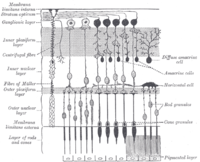
Photo from wikipedia
Neurodegenerative diseases are characterized by neuronal death and regenerative failure. However, gene regulatory programs governing how initial neuronal injuries lead to neuronal death remain poorly understood. In adult mice, optic… Click to show full abstract
Neurodegenerative diseases are characterized by neuronal death and regenerative failure. However, gene regulatory programs governing how initial neuronal injuries lead to neuronal death remain poorly understood. In adult mice, optic nerve crush (ONC) injury, which severs all axons of retinal ganglion cells (RGCs), results in massive death of axotomized RGCs and regenerative failure of survivors. We performed an in vivo CRISPR/Cas9-based genome-wide screen of 1893 transcription factors (TFs) to seek repressors of RGC survival and axon regeneration following ONC. In parallel, we profiled the epigenetic and transcriptional landscapes of injured RGCs by ATAC-seq and RNA-seq to identify critical injury responsive TFs and their targets. Remarkably, these independent analyses converged on a set of four ATF/CEBP transcription factors – ATF3, ATF4, C/EBPγ and CHOP (Ddit3) – as critical regulators of survival. Further studies indicate that these TFs contribute to two pro-death transcriptional programs: ATF3/CHOP preferentially regulate pathways activated by cytokines and innate immunity, whereas ATF4/C/EBPγ regulate pathways engaged by intrinsic neuronal stressors. Manipulation of these TFs also protects RGCs in an experimental model of glaucoma, a prevalent disease in which RGCs die. Together, our results reveal core transcription programs that transform an initial axonal insult into a degenerative result and suggest novel strategies for treating neurodegenerative diseases.
Journal Title: Neuron
Year Published: 2022
Link to full text (if available)
Share on Social Media: Sign Up to like & get
recommendations!